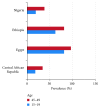Female Genital Mutilation: Health Consequences and Complications-A Short Literature Review
- PMID: 30116269
- PMCID: PMC6079349
- DOI: 10.1155/2018/7365715
Female Genital Mutilation: Health Consequences and Complications-A Short Literature Review
Abstract
Female genital mutilation (FGM) is a procedure performed on women in developing countries and is underreported; it involves cutting or altering the female genitalia. The health consequences of FGM include bacterial and viral infections, obstetrical complications, and psychological problems. In this study, we report FGM societal importance, ramifications, classifications, cultural significance, prevalence, complications, implications, and treatment. Although efforts have been made to eradicate FGM, the dynamics that perpetuate the practice have societal roots. Intervention methods to promote change from within the community are necessary for successful eradication of the practice. For prevention, further studies are needed to develop programs that raise awareness.
Figures


References
-
- Donohoe M. Female Genital Cutting: Epidemiology, Consequences, and Female Empowerment. 2006. http://www.medscape.com/viewarticle/546497.
-
- World Health Organization. Female Genital Mutilation. 2016. http://www.who.int/mediacentre/factsheets/fs241/en/
Publication types
LinkOut - more resources
Full Text Sources
Other Literature Sources

